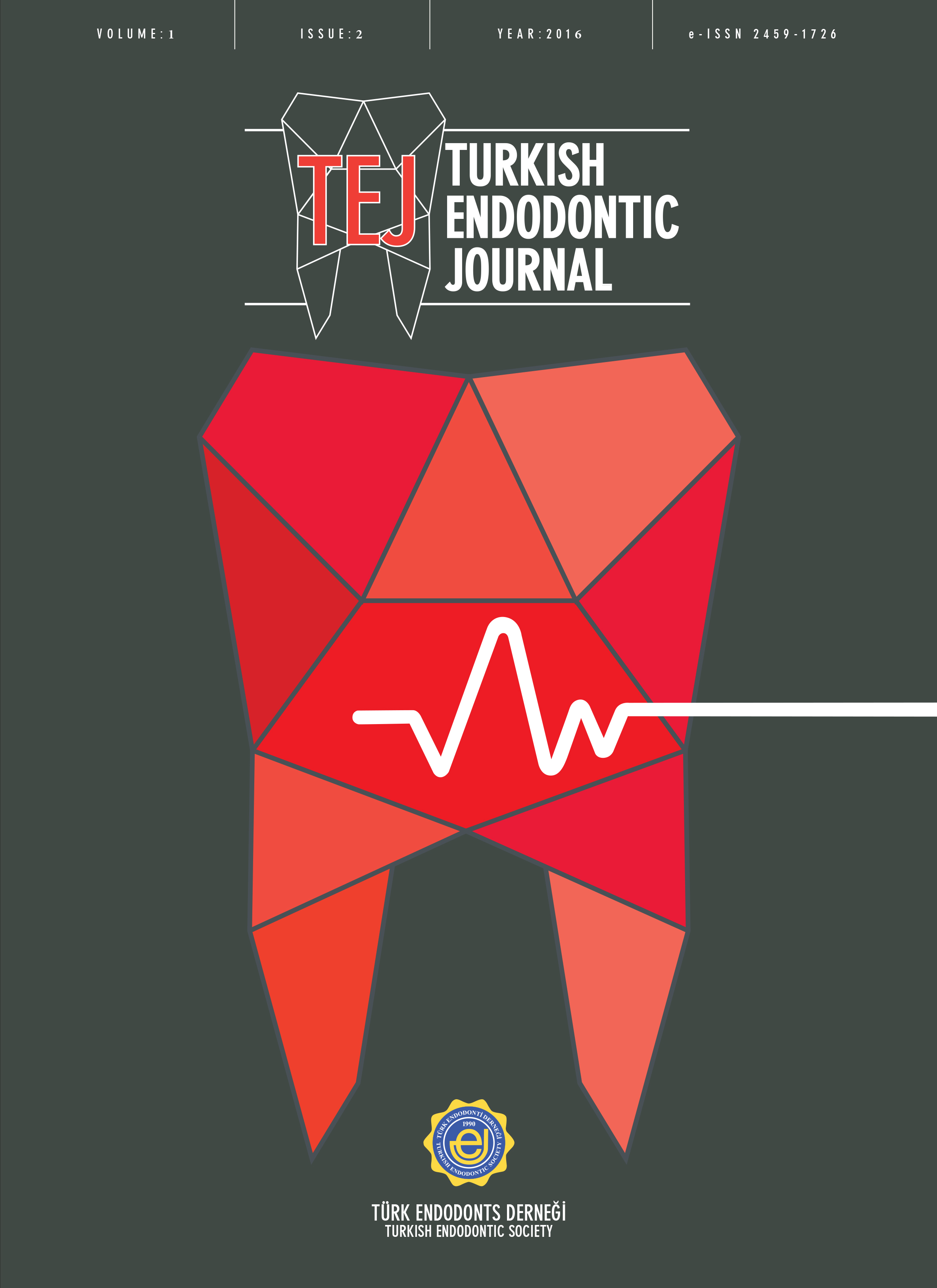Volume: 1 Issue: 2 - 2016
| EDITORIAL | |
| 1. | From The Chairman Faruk Haznedaroğlu Page I |
| 2. | From The Editor Jale Tanalp Page II |
| ORIGINAL RESEARCH | |
| 3. | Evaluation of push-out bond strength of different adhesive system applications Emel Olga Önay doi: 10.14744/TEJ.2016.40085 Pages 55 - 60 Objective: To compare interfacial strength and failure modes of glass-fibre endodontic posts luted with three different adhesive luting agents. Methods: A total of 30 extracted human maxillary incisors were randomly divided in three groups and restored using glass-fibre posts and the following luting agents: an experimental self-etching primer/resin-cement MSM-107 (EXP), ExciTE® F DSC adhesive/Variolink II (VII), Gradia Core self-etching bond/Gradia Core cement (GC). Five sections of 1.00±0.05 mm thickness were prepared from each specimen, and the post in each section was subjected to a push-out test. Failure modes of root slices after push-out testing were examined with stereomicroscope. The level of significance was set at alpha=0.05. Results: EXP achieved the highest bond strength. The mean value recorded for GC was significantly lower than EXP (p<0.05) and did not differ from VII (p>0.05). There was also no significant difference between EXP and VII (p>0.05). Bond failure was mainly mixed failure for VII and GC. Adhesive failures between the cement and the post, cohesive failures within the post and the dentin were mostly observed in EXP. Conclusion: The new experimental resin cement, MSM-107 showed promising results in term of bonding ability and might be used efficiently to restore endodontically treated teeth. |
| 4. | Fracture resistances of roots prepared with rotary files with different metal alloys and motion kinetics Emel Uzunoglu, Eda Ezgi Aslantaş, Sevinç Aktemur Türker doi: 10.14744/TEJ.2016.66375 Pages 61 - 66 Objective: To compare the forces required to vertically fracture roots prepared with files made of different metal alloys and applied with different motions during preparation. Methods: A total of 60 decoronized mandibular incisors that were balanced with respect to buccolingual-mesiodistal diameters were selected. Fifteen unprepared roots were selected as controls. The remaining 45 specimens were assigned randomly into the following experimental groups: preparation with the ProTaper Universal (Group 1), preparation with the ProTaper Next (Group 2) and preparation with the Reciproc (Group 3). The prepared and unprepared samples were loaded vertically at a crosshead speed of 1 mm/min until vertical root fracture occurred. The results were statistically evaluated with 1-way analysis of variance and Tukey’s post-hoc tests. Results: Statistically significant differences between groups were detected (P<.05). The statistically highest mean fracture resistance was obtained in the control group. There were no significant differences between the forces required to fracture the prepared samples (p>.05). The majority of samples were fractured catastrophically in a labiolingual direction. Conclusion: The prepared samples were more prone to vertical root fracture compared with the unprepared samples. Neither motion kinematics nor the alloys of the files significantly influenced the fracture resistances of the prepared roots. |
| 5. | A survey on clinicians preferences in reducing postoperative pain in endodontic practice Hakan Arslan, Fatih Seçkin, İsmail Davut Çapar, Hany Mohamed Aly Ahmed, Eyüp Candaş Gündoğdu doi: 10.14744/TEJ.2016.14633 Pages 67 - 72 Objective: The aim of the present study is to investigate the preferences of general dental practitioners and endodontists in the management of postoperative pain. Methods: An electronic questionnaire was prepared, and then sent to all members (n=11253) of an internet group (International Association of Endodontic Education, Research and Practice). Chi square test was used for data analysis, and the level of significance was set at 0.05. Results: Results showed that 85.5% of the participants expect postoperative pain and prescribe analgesics in patients with preoperative pain (p<0.001), and 32.8% of the participants expect postoperative pain and prescribe analgesics in retreatment cases (p<0.001). Expectations of postoperative pain from using the hand files was the highest among other instrumentation techniques, and the difference was statistically significant (p<0.001). The most preferred drug type prescribed by the participants is NSAIDs (42%) (p<0.001). More than half of the participants do not prescribe a combination with narcotic for the management of postoperative pain (p<0.001). Conclusion: In conclusion, postoperative pain remains a frequent suspected sequelae of endodontic procedures, especially in patients with preoperative pain and retreatment cases. The management of postoperative pain and methods for prevention show wide variations. A universal agreement is required to standardize methods to manage and prevent postoperative pain. |
| 6. | Apical extrusion of intracanal biofilm after root canal preparation using Revo-S, Twisted File Adaptive, One Shape New Generation, ProTaper Next, and K3XF instrumentation systems Recai Zan, Huseyin Sinan Topcuoglu, Tutku Tunc, Senem Gokcen Yıgıt Ozer, Ihsan Hubbezoglu, Gizem Kutlu doi: 10.14744/TEJ.2016.36844 Pages 73 - 79 Objective: To evaluate the amount of bacteria extruded apically during instrumentation using different nickel titanium (NiTi) rotary instruments. Methods: Eighty extracted single-rooted human mandibular premolar teeth were inoculated with E. faecalis to obtain biofilm formation and the re-inoculation procedure was performed on the first, fourth, seventh and tenth days. The infected root canals were prepared using Revo-S (RS), Twisted File Adaptive (TFA), One Shape New Generation (OSNG), ProTaper Next (PTN), and K3XF instrumentation systems. The amount of apially extruded bacteria was incubated in brain heart infusion agar and it was measured in colony forming units per milliliter. Data were analyzed using the one-way analysis of variance (ANOVA) and Tukey post-hoc tests. Results: The RS group caused more bacterial extrusion compared to other groups (p<0.05). Although the OSNG and K3XF caused the less amount of bacteria extrusion than TFA and PTN groups (p<0.05), there was no statistically significant difference between OSNG and K3XF (p>0.05). TFA extruded more bacteria compared to the PTN group (p<0.05). Conclusion: All NiTi instrumentation systems were associated with apical extrusion of biofilm. OSNG and K3XF appear to be safer instruments in terms of biofilm extrusion compared to other instruments. The apically extruded bacteria may vary according to the instrument metallurgy, kinematics and design. |
| 7. | A comparative evaluation of the retreatment efficiency of the Self-Adjusting File system and other root canal instrumentation techniques Tuğrul Aslan, Burak Sağsen doi: 10.14744/TEJ.2016.47966 Pages 80 - 86 Objective: The aim of this study was to compare the retreatment efficiencies and durations of H-file, Mtwo, Revo-S and SAF instruments. Methods: 60 maxillary central incisors were used. Specimens were prepared by step-back technique and MAF was. 02/35 K-file. Root canals were irrigated, and dried; then, filled with gutta-percha and a sealer using cold lateral condensation technique. Canal filling removals were performed with. 02/35 H-file and solvent. Specimens were randomly divided into 4 groups (n=15). In final instrumentation: G1–.02/40 H file; G2-.06/40 Mtwo; G3-.06/40 Revo-S; G4- 2.0-mm SAF were used. Times required for retreatment were recorded. Final rinses were performed and root canals were dried with paper-points. Roots were split longitudinally and assessed by stereomicroscope at 6X magnification. Statistical analysis were done (α=0.05). Results: There were no significant difference among root canal thirds and entire root canal surfaces of the groups (p>0.05). There were significant difference among the groups in terms of required retreatment time (p<0.05). Conclusion: Although, SAF group was found as the slowest system among the tested groups, further retreatment studies on different the usage times of the SAF system, the usage combined with solvents and the usage in more challenging canal anatomies are needed. |
| CASE REPORT | |
| 8. | Accidental displacement of gutta-percha to the lingual periosteum: a case report Adnan Kılınç, Bahadır Sancar, Nesrin Saruhan, Ümit Ertaş doi: 10.14744/TEJ.2016.43153 Pages 87 - 90 Debridement and complete obstruction of a root canal system are success criteria of root canal treatment. Endodontic failure is usually due to broken instruments, perforations, overfilling, underfilling, and ledges. Root perforation and the accidental displacement of a gutta-percha point from the periosteum to bone is a rare complication in clinical dental practice. The aim of this report is to present a clinical case of accidental displacement of two gutta-perchas to lingual periosteum in the mandibular premolar region, along with its surgical treatment. After surgical removal of the gutta-perchas, the patient’s clinical symptoms were eliminated. Surgery is the most accepted treatment for accidentally displaced gutta-percha. |
| 9. | Inferior alveolar nerve damage after extrusion of an endodontic sealer into the mandibular canal: a case report Zeliha Yılmaz, Emel Uzunoglu, Ozge Erdogan doi: 10.14744/TEJ.2016.29392 Pages 91 - 95 The aim of this case report was to discuss the consequences and treatment options of inferior alveolar nerve damage after the overextension of an endodontic sealer into the mandibular canal. A 33-year-old female patient was referred to the clinic of endodontics with persistent numbness around her left commissura as a consequence of her initial endodontic treatment of a lower left first molar. The patient’s complaints started to occur after the anesthesia has worn off. An endodontic sealer was extruded and spread into the mandibular canal, which caused anesthesia, paresthesia and tingling sensation around the left part of lower lip. Performing an interdisciplinary framework with the department of oral surgery, it was decided to monitor the patient regularly without any surgical intervention in order not to cause more trauma to the inferior alveolar nerve and not to jeopardize the present health status of the patient. Although damage to the inferior alveolar nerve is a relatively rare complication in dental practice, longlasting consequences of such a complication stress the significance of showing absolute attention and care during all endodontic. |
| 10. | Foreign material in a maxillary sinus as a complication of root canal treatment: a case report Nesrin Saruhan, Adnan Kılınç, Tahsin Tepecik, Ümit Ertaş doi: 10.14744/TEJ.2016.21939 Pages 96 - 98 The roots of maxillary teeth proximity to maxillary sinuses can lead to overfilling of endodontic materials to maxillary sinuses accidentally. In some cases, overfilling of endodontic materials require surgical procedures. Foreign endodontic material within the maxillary sinus after endodontic treatment on extracted tooth #15 is presented in this case report. Foreign material inside the maxillary sinus was removed successfully by Caldwell-Luc operation. Postoperative healing was uneventfully. |
| 11. | Non-surgical endodontic treatment of premolars with three root canals: a case reports Salih Düzgün, Ahmet Aktı, Hüseyin Sinan Topçuoğlu, Melek Hilal Kaplan doi: 10.14744/TEJ.2016.83803 Pages 99 - 103 An accurate diagnosis of the morphology of the root canal system is a prerequisite for successful root canal treatment. Some reports reveal a very rare occurrence of all types of premolar teeth in the Turkish population. Diagnostic tools such as preoperative radiography and examination of the pulp chamber floor facilitate the location of root canal orifices. The use of magnification tools, radiography exposed at two different horizontal angles, and their careful explication are important for successful endodontic therapy. This case report presents the successful endodontic treatment of three maxillary premolar teeth with three root canals and one mandibular premolar tooth with three root canals. |


















